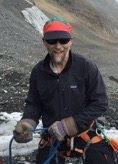There (to Narsarsuak, then Raven) and back again.
In the morning, the weather looked poor at Raven, so it turned out to be a fine thing that we were going to fly to Narsarsuak first. We loaded up on the plane, and headed south, carrying, in addition to Steve, me, and our gear for Raven, 2 members of the G-NET team who were to be setting up continuous- monitoring GPS stations in the area, along with about 8,000 pounds of thier equipment.
The flight to Narsarsuak went smoothly, with mostly no particular scenery, but when we got close to Narsarsuak we came down through the clouds and there were some very nice glaciers to see. in particular we noticed one with a peculiar set of moraines:

Here you can see that there are 2 tributary glaciers 'feeding' the main trunk of the glacier, but the moraines tell an interesting story: The tributaries must be stagnating, because otherwise the moraines where they join the main glacier would not be straight across as they are, but would arch out into the main glacier, as can be seen in this picture.
We landed and offloaded our cargo and passengers in Narsarsuak, not without the standard delays one might expect when one needs a forklift to unload the plane. When we got ready to depart, the pilots told us that they were not optimistic about our chances to get into Raven, but that we'd try anyway. Not seeing anything through the small portholes, I began to think we might make it when I saw the loadmaster, who had direct communications with the pilot through his headset, change from his eyeglasses to his sunglasses, and start fastening the cuffs of his flightsuit.
We landed, and arrived at Raven, population 2:

Those 2 are Drew and Silver, who welcomed us warmly, gave us fuel, supplies, and food, and helped us on our way.
We first went to my site, about 5 km from Raven, where I made my video measurements. At the same location (or rather, around 100 yards upwind), Steve started taking his samples. We finished that site and moved to a location 10 km from camp, where Steve took some more samples.
Steve's looking at soot, or balck carbon, concentration in the snow. Such soot may not turn the snow black, may be hardly notable by the eye, but has a strong affect on the albedo of the snow, a measure of how much radiant energy is returned.

Steve is collecting snow samples in ball canning jars. He plans to melt them , filter them, and look for signs of soot.
We wen to one final site, 20 km from camp, collected samples, and headed for home, where Drew and Silver were waiting for us with a wondeful coconut curry. We had dinner, chatted a but and caught up (last time I'd seen Drew and Silver was 2 years ago), and went to bed. In the morning, a plane came, did some takeoffs and landings for practice, and then took us back to Kangerlussuaq, from where I write this.
Tomorrow morning, weather permitting (again), it'll be off to Summit!


0 Comments:
Post a Comment
<< Home